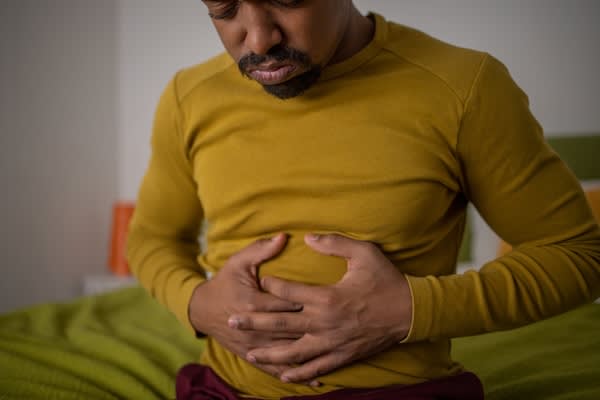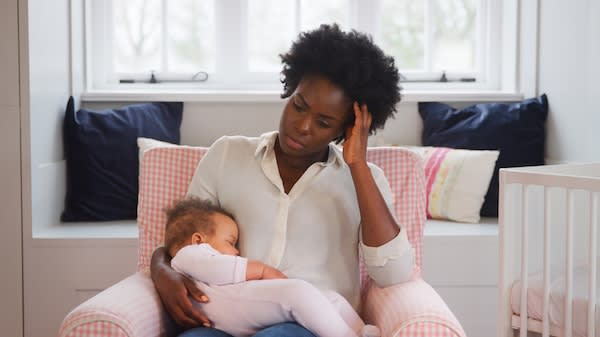Stomach pain after eating: Causes and when to see a doctor

[6 MIN READ]
In this article:
- Stomach pain after eating is common and often linked to indigestion, gas or food intolerances.
- More serious causes include gallbladder issues, ulcers, gastroesophageal reflux disease (GERD) or irritable bowel syndrome.
- Relief options range from movement and hydration to over-the-counter medications. Persistent or severe pain warrants medical care.
Stomach pain after eating: Causes and when to see a doctor
Have you ever felt stomach pain after eating? You’re not alone. In fact, according to a global survey, 1 in 10 people worldwide say they frequently experience abdominal pain after eating a meal.
Sometimes called postprandial pain, stomach pain after eating can have a number of causes, ranging from mild indigestion to more serious gastrointestinal conditions like gallbladder issues or gastroesophageal reflux disease (GERD).
Daniald Rodrigues, M.D., a gastroenterologist at the Providence Center for Digestive Health — Mission Viejo in Mission Viejo, California, helps break down common causes — including a few potentially serious culprits — as well as how to find relief and when to seek medical attention.
Common causes of stomach pain after eating
Stomach pain after eating is common because eating is something we do every day, Dr. Rodrigues says.
“We’re all eating every day, so our gut is doing a lot of work on a daily basis,” he says. “And stressful times can make one more cognizant of the digestive process and lead to gut distress.”
Overeating and eating too quickly
Indigestion is the most common cause of stomach pain after eating, Dr. Rodrigues says. Also known as dyspepsia, indigestion is typically caused by overeating, eating too quickly, or eating fatty or spicy foods. But stress can make it worse.
Gas and bloating
Although gas is a normal byproduct of the digestion process, it can become trapped in the abdomen, leading to pain and bloating.
Swallowing air while eating or drinking — often because you’re eating or drinking too quickly or drinking a carbonated beverage — can also cause gas to build up.
Food intolerances and sensitivities
Sometimes, stomach pain after eating is due to a food intolerance or sensitivity. These can cause symptoms like gas, bloating, diarrhea and cramping when the body has trouble digesting certain foods.
Lactose intolerance and gluten sensitivity are common examples.
Spicy or fatty foods
Spicy foods tend to include chili peppers, which contain capsaicin, a chemical that gives them their hot or burning sensation. Capsaicin can irritate the stomach.
Fatty foods can also slow down digestion and irritate the digestive system, resulting in indigestion and symptoms including nausea and bloating.
Constipation
Constipation can stem from a whole slew of factors — including not eating enough fiber, not drinking enough water and not getting enough exercise. When you’re constipated, digestion slows down, causing stomachaches and cramping.
More serious conditions to consider
If stomach pain after eating isn’t severe and doesn’t last long, it’s likely not serious, Dr. Rodrigues says. But if it’s persistent, intense or accompanied by other concerning symptoms, you should talk to your doctor or schedule an appointment with a gastroenterologist.
Gallbladder problems
The gallbladder is a small organ located under the liver. It stores bile, a digestive fluid the liver produces, and releases it into the small intestine to aid digestion.
Certain problems with the gallbladder can cause stomach pain after eating, such as:
- Cholecystitis (inflammation of the gallbladder, often due to gallstones)
- Gallstones (hard masses that form from bile and can cause blockages)
If you believe you may have gallbladder issues, contact your doctor for an evaluation.
Peptic ulcers
Peptic ulcers develop as open sores in the lining of the stomach or duodenum (the first part of the small intestine). When these sores form, the stomach’s digestive acids irritate them, causing pain. Pain from peptic ulcers can either be dull or burning, and may come and go over time.
Gastritis and GERD
Gastritis refers to the inflammation of the stomach lining. It’s often caused by infection, but drinking too much alcohol can make it worse. Gastritis can lead to ulcers and even to an increased risk of stomach cancer. Pain associated with gastritis typically feels like the achiness caused by indigestion.
GERD is a digestive disease caused by stomach acid flowing back up into the esophagus, irritating its lining and causing symptoms like chest pain and heartburn.
Irritable bowel syndrome (IBS)
IBS describes a group of symptoms that affect the lower stomach, such as abdominal discomfort and pain, diarrhea, constipation, bloating and cramping.
IBS-related pain is often triggered by eating certain foods.
Inflammatory bowel disease (IBD)
Although it’s associated with similar symptoms to IBS, IBD is an umbrella term for autoimmune conditions like Crohn’s disease and ulcerative colitis, which cause damage to the digestive tract and inflammation.
Compared to IBS, IBD can have more severe and potentially long-term complications.
Upper vs. lower stomach pain: What’s the difference?
Doctors use anatomy when determining what may be causing stomach pain. They divide the abdomen into regions to help diagnose problems based on symptoms and their location. The upper abdomen includes the breastbone to the belly button, while the lower abdomen is below the belly button.
Upper abdominal pain causes
Like all pain that affects the stomach, pain in the upper abdomen can have many causes. Some of the most frequent are:
- Digestive issues, including acid reflux and GERD, constipation, indigestion, heartburn and gas
- Muscle strain
- Stress and anxiety
In addition, because of its location, the gallbladder is a common culprit behind pain in the upper abdomen. For example, obstruction in the biliary tract — typically in the bile ducts or gallbladder — can cause biliary colic, which is severe but intermittent pain in the upper right abdomen.
Lower abdominal pain causes
Similarly, pain in the lower abdomen can relate to the bowels. For example, ischemia, which is restricted blood flow to the bowels, causes achy pain that strikes about an hour or two after eating.
Some of the common causes of lower abdominal pain include:
- Digestive conditions, including IBS and IBD
- Digestive issues, like gas and bloating, food intolerances and sensitivities
- Diverticulitis (an inflamed section in the lining of the large intestine)
- Food poisoning
Immediate relief: What you can do at home
Relief from stomach pain after eating depends on the cause. For common digestive issues, you can try certain remedies at home.
Position and movement
Sometimes, just taking a walk or a stroll, or performing light stretching or yoga poses, can help stimulate digestion and reduce gas and bloating.
In addition, lying on your side or with your knees to your chest may help move gas and relieve pain.
Heat therapy
Applying heat with a heating pad, warm compress or hot water bottle — or taking a warm bath or shower — also can help relax muscles, promote digestion and reduce pain.
Hydration and gentle foods
Simply drinking water and avoiding spicy and fatty foods, as well as alcohol, can help soothe the digestive tract and aid in digestion.
Alcohol is a known gut irritant that causes irritation to the stomach lining, Dr. Rodrigues says.
Over-the-counter options
You can try reaching for a fast-acting acid reducer like Pepcid® or Prevacid®. Other types of over-the-counter medications, like Pepto-Bismol®, Rolaids® and TUMS®, can also help with common digestive problems, like heartburn, gas and bloating.
Red flag symptoms: When to seek emergency care
If you’ve tried home remedies and over-the-counter medications for a few days but you still have pain that’s progressively getting worse, it’s time to call the doctor or even go to the emergency room.
Some of the red-flag symptoms related to stomach pain after eating include:
- A high fever
- Abdominal swelling
- Bloody or black stools
- Inability to keep down fluids
- Severe pain
- Vomiting blood
Finally, Dr. Rodrigues says, “If you’re having pain with every meal and after everything you eat, it’s probably something you need to bring up to your doctor.”
Providence offers same-day and urgent care appointments for your convenience. If you’re experiencing any of these symptoms, don’t wait to get checked out!
Contributing caregiver

Daniald Rodrigues, M.D., is a gastroenterologist at the Providence Center for Digestive Health — Mission Viejo in Mission Viejo, California.
Find a doctor
If you are looking for a primary care provider or gastroenterologist, you can search for one who’s right for you in our provider directory. You can also find out more about our gastroenterology services.
Download the Providence app
It’s all in the app: easily stay connected with Providence and your health. With the Providence app, you can schedule appointments, have virtual visits from the comfort of your own home, get health recommendations personalized for you, access your health records and so much more. Learn more and download the app.
Related resources
Understanding your stomach pain: When to worry
Upper abdominal pain: Causes, symptoms and relief
Left side stomach pain: When it’s time to see a doctor
Sharp stomach pain: Causes and when to see a doctor
This information is not intended as a substitute for professional medical care. Always follow your health care professional’s instructions.


